 |
| Hindman |
Hindman's plan was to send Marmaduke with the rebel cavalry to strike Blunt from the south as a diversion, while he hit the Federal flank from the east. However, as he drew close to the Yankees he changed his mind and decided to continue on around Blunt, receiving word that the Union reinforcements were arriving. Francis Herron, upon the receipt of Blunt's order, relentlessly pushed his men on a forced march so that he could arrive in time for the battle. Hindman, loosing his usual aggressive nature, took up a defensive position in the low hills of Prairie Grove.
 |
| Blunt |
Herron began the Battle on December 7th, deploying his tired troops on Hindman's right and commencing a two hour artillery bombardment. Seeing that his artillery had been very successful, destroying the rebel guns and forcing the infantry to lie down on the reverse slope of the hill, Herron ordered an attack to make use of this opportunity without waiting for cooperation from Blunt's forces. However, the first two regiments set forward met disaster near the Borden House, meeting a counterattack from three sides. The Federals fell back, and soon were running back in disorder to their lines, having lost about half their number. Trying to make the most of this gain, the Confederates launched a disorganized attack on Herron's line, but were driven back by canister from the Yankee guns.
Herron ordered two more regiments to attack in the area of the Borden House, hoping to forestall any movements the Confederates might make. Again they were driven back after fierce fighting, and then drove back a southern counterattack. By this time Blunt realized that Hindman had bypassed his position, and so ordered his troops to march to the sound of fighting. Ignoring the roads and just marching through the fields, his leading elements arrived on the Confederate flank just as they were preparing to launch another attack. They surprised the Confederates and foiled their attack. The fighting continued to sway back and forth until nightfall put an end to the battle.
 |
| Herron |
Although tactically the battle was a draw, neither army having won a clear victory, the Union certainly won strategically. The two Union forces had been able to join without being first destroyed by the Confederate attacks, and Hindman saw no choice but to retreat with no reinforcements or ammunition available to continue the battle on the morrow. He arrived with his defeated army in Van Buren, Arkansas on December 10th, and near the end of the month was driven out of the nortwest part of the state completely by an advance by the Yankee forces.



0 comments:
Post a Comment